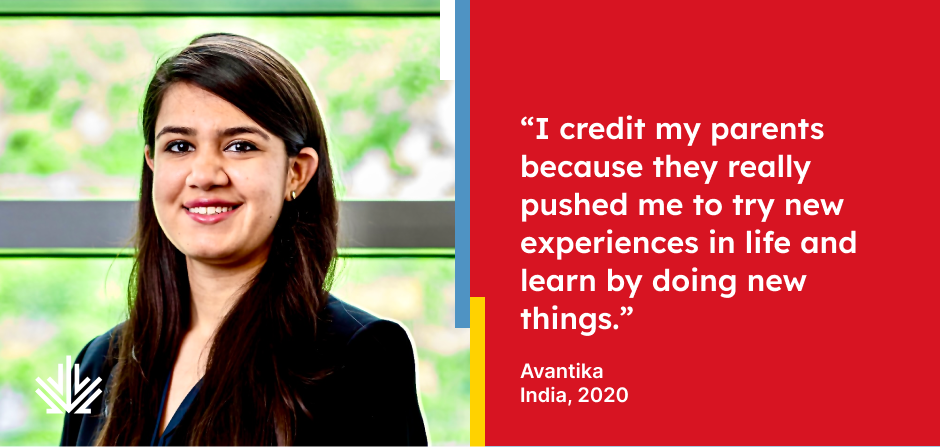From an interview with Avantika Sardana.
Avantika Sardana was born and raised in New Delhi, India and worked in human capital before she decided to spice things up and take her career to the next level: the managerial level. This meant going back to school to do an MBA. In 2020, Avantika was accepted on scholarship in the prestigious MBA program at the University of Toronto’s Rotman School of Management. Since many international students may be thinking about or actually planning to continue their studies in Canada, we asked Avantika to walk us through her experience and provide a few tips on everything from study permits, flipping her schedule upside down to match Toronto time during COVID, finding housing, internships, networking, and building the foundations for a career doing what she loves in Canada.
When deciding to do my MBA, I researched schools in India and abroad. I considered which place would be the land of opportunity and where I’d like to live. Canada was at the top of my list.
Canada is a very diverse country. It has a multitude of nationalities and that’s what makes it so beautiful. Apart from that, coming from India, the quality of living is definitely much better in Canada, and there are many more opportunities in the Canadian market.
I wanted to upskill and get the management knowledge I needed to move to the next level of my career, so I applied to the MBA program at the Rotman School of Management which is the top MBA program in Canada. The application process included a 1,000-word essay along with transcripts, a GMAT or a GRE score, two video interviews and a final interview with the admissions director. Just before Christmas I received an acceptance offer. I was ecstatic! I was fortunate enough to also receive a scholarship, and looked forward to coming to Rotman as soon as possible. Unfortunately, due to the pandemic, I had to start my MBA while I was still in India, in a remote working environment.
EST vs IST: Turning your time zone upside down
Toronto’s Eastern Standard Time (EST) is ten hours behind India Standard Time (IST). So, morning class at 9:00 a.m. in Toronto was 6:00 p.m. in India. These classes might go until about 9:00 p.m. IST. After-class extracurriculars through club activities, like meeting companies, interviewing, and participating in case competitions, are a very big part of an MBA experience. The challenge was that these important networking events took place in the evening in Toronto, which was the middle of the night for students in India.
We used to stay up the entire night waiting to have those calls. It would be pitch dark outside, 3:00 a.m., 4:00 a.m., and we would be in our suits attending networking events or taking interviews. What really kept me on track was remaining connected with my cohort members. I made some really good friends, although it was all online. We used to have Zoom sessions where we would discuss everything under the sun, and play games together to keep ourselves motivated and just know about what’s going on in everybody’s lives. After coming to Canada, it was a very refreshing change to actually wake up in the morning and go through my routine like a normal person. I ramped up my extracurricular activities and networking because I felt physically much better working during the daytime instead of the nighttime.
Finding a place to live in Canada as a student
There are different types of housing in Canada, and I was looking for an apartment to rent in Toronto. First off, the prices here are quite high, and it does take a while to find the place that’s right for you. Before I came to Toronto, I booked student housing at the University of Toronto called Graduate House. I arrived in Canada in the middle of winter and was not used to that kind of weather. I knew I would have to quarantine for 14 days and did not want the additional stress of looking for a house, so I stayed in the student housing for about six months. While there, I spoke to a realtor and looked for apartments. It took about three months, but I finally found the apartment I currently share with one of my classmates. I also learned about tenants’ rights and responsibilities in Ontario.
I didn’t know you need a credit score to rent a home in Canada. I didn’t really understand credit and credit scores before coming here. In India, most people use a debit card. They stay away from loans and credit cards. So that was a change I had to make in my life. I learned that to build your credit history, you need to use your credit card and pay the bill on time. That keeps your credit history proper. Another thing that affects your credit history is paying your phone bill on time. So I ensured that both my phone bill and my credit card bill were always paid on time. Since I had been living in Toronto for about six months when I rented my apartment, I did have a credit history and my credit score was also good.
SDS: Student Direct Stream
The SDS program helps you get your student visa faster. To qualify, in addition to the letter of acceptance and supporting documentation, you’ll need a Guaranteed Investment Certificate (GIC). A GIC is basically an investment certificate you make with a bank in Canada. It has a guaranteed rate of return for a fixed amount of time. Every month, the bank gives you a certain amount of your investment. This way, The Government of Canada knows you have money to sustain yourself while studying in Canada. Another benefit of having a GIC is you don’t need to keep on sending money from your home country to Canada every month.
Although I did feel a little discomfort investing that money, because obviously you are investing a huge chunk of money in addition to paying your tuition fees, I am in a better place today because the exchange rates really went up after I came to Canada.
PGWP: Post Graduate Work Permit
In Canada, many international students are eligible for a Post Graduate Work Permit (PGWP) once they graduate, which is good for up to three years. It is quite beneficial for international students and one of the major reasons why I chose Canada over any other country to do my MBA.
The PGWP makes me feel less stressed as an international student. Had I been in any other country, I may have only had a one year grace period to look for a job and prove myself in the job so that I could continue further. I think that would have really given me a lot of stress. The three year work permit gives me enough runway to find a great job and perform well here.
Avantika’s top five tips for studying in Canada
1. Be prepared to say yes to opportunities
Be as invested as possible in the international student experience. Do your readings and study as much as you can. Study hard, but at the same time, ensure that you take time out to spend with your friends and colleagues. The beautiful part about Canada is its diversity. You’ll meet people from different countries and backgrounds, so take some time to understand their journeys. Learning outside of the classroom will teach you so much and will be much more helpful in building your future than just what you learn in the classroom. Spend time with your professors and use as many networking opportunities as you can to meet new people.
2. Network: Reach out to new people
As an MBA student, networking has really helped me; it’s fulfilling and valuable to meet people and understand their journeys and how they’ve made it to where they are. Everyone has a story to tell. The fact that I am doing a two year MBA program gives me the opportunity to meet new people and understand the Canadian job market.
For example, when I came to Canada, I didn’t know Toronto was the centre for banking. The day I arrived, I was traveling to my quarantine hotel and noticed all these large buildings with the major bank logos. I reached out to leadership professionals from the financial industry to understand the different opportunities available in the banks. It got me really interested.
So, get comfortable meeting new people and speaking with professionals from different companies. It does take a bit of courage to take the first step, especially when you’re in a foreign land. In Canada, you are an individual entity; you create your own story. So reach out on LinkedIn. And when you send a LinkedIn request, do add a customized message so the recipient knows the reason why you are reaching out to them and how they might help you.
3. Get your finances in order
Before coming, it’s a good idea to create an Excel spreadsheet and input your expected monthly expenses in Canada. Take into account the tuition fee, rent you’ll have to pay every month and your cost of living, which includes food, clothing, transit, going out with friends, etc. You should know basically how much money you will need every month.
4. Work while you’re at school
If your education allows it, and you have the bandwidth, I suggest doing an internship or taking a part-time job. Legally, many international students are allowed to work off-campus 20 hours a week. So if that is a possibility, and if you are able to secure a job, then why not? It can help you manage your finances and it’s an excellent way to understand Canadian culture. Working part-time, I met regular people from different backgrounds and age groups and learned how they go about their lives––what they do on the weekends, what are some interesting ways to spend time, and how things work in Canada.
5. Take time for your physical and mental health
I did not know the importance of getting sun until I started doing my MBA remotely. There were days I didn’t get out of my house because I was sleeping during the day and attending classes at night. I was always stuck to my laptop. I felt there was something missing and I wasn’t feeling great about carrying on with my daily life. So, in the morning before sleeping, I started to go out and spend some time in the sun.
I also ensured I had a routine. I’d wake up at a certain time, meditate for about 15 minutes, and then work out for about 45 minutes. I maintained a good diet. What you eat has an impact on how you feel. So I made sure that I was eating healthy and doing healthy things to keep me going for all the work that I had to do, even if my entire day was upside down.
“I keep doing what makes me happy and brings out my creativity to be successful in whatever I do.”
My goal in the next few years is to work in a Canadian company where I am able to leverage my strengths to create an impact on the business while also looking at the future ahead in Canada. I would like the opportunity to showcase my expertise and knowledge in human behaviour and business design, two areas I am deeply passionate about.
Business Design is the customer-centric mindset you develop to solve business problems. I am now the president of the Business Design Club and have attained the Business Design Fellowship at Rotman. I’m really looking forward to connecting what customers really want to the problem a company wants to solve.
Since coming to Canada, I keep doing what makes me happy and brings out my creativity to be successful in whatever I do. I credit my parents because they really pushed me to try new experiences in life and learn by doing new things. From exploring Toronto, going on hikes in and around the city and traveling to Calgary and The Rockies, I am experiencing Canada and learning more about the country while I complete my MBA. I am not yet a Permanent Resident (PR), but hope to apply upon completion of my education. Canada’s diversity and opportunities attracted me here, and I can see myself being in Canada for the long term.





